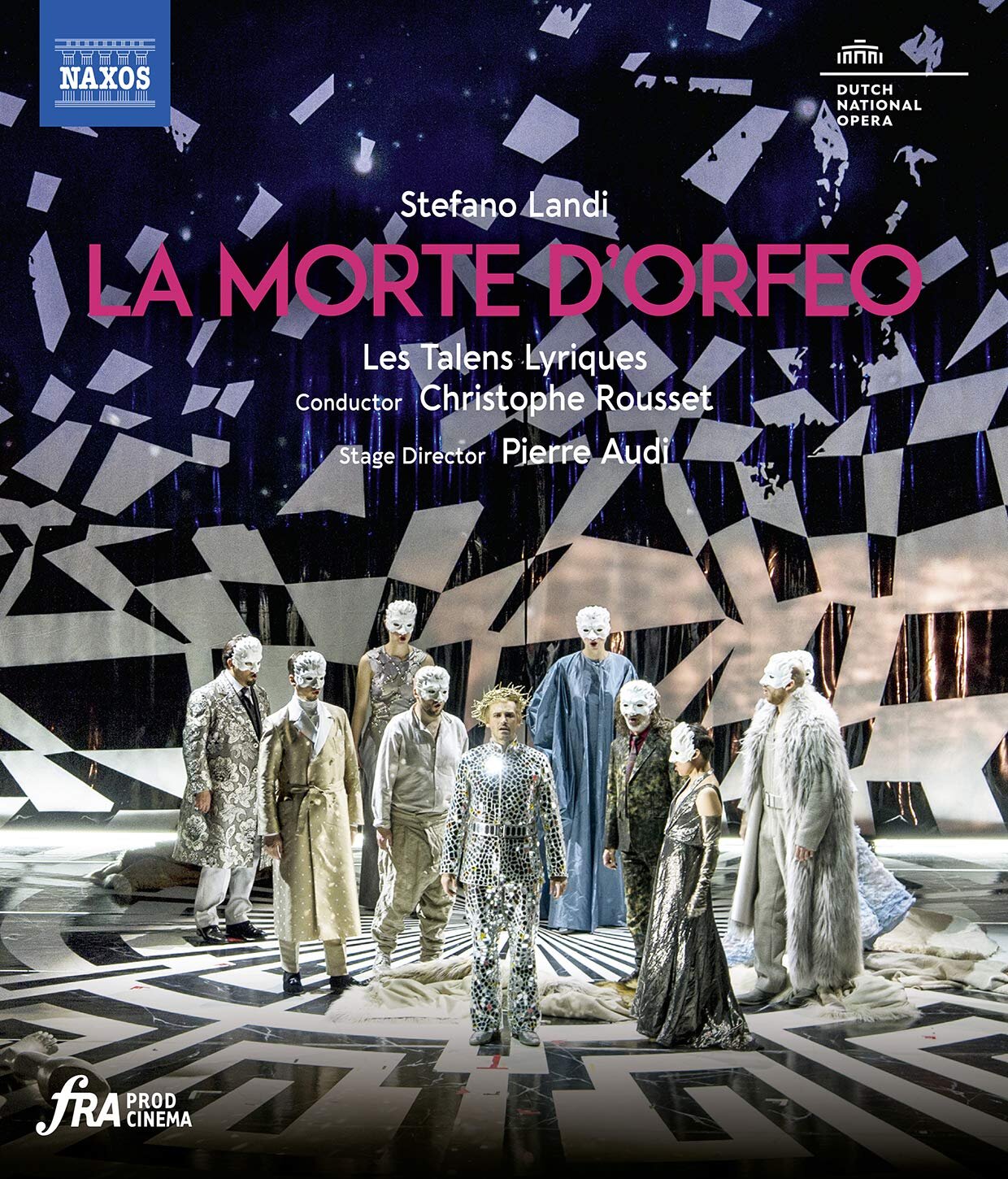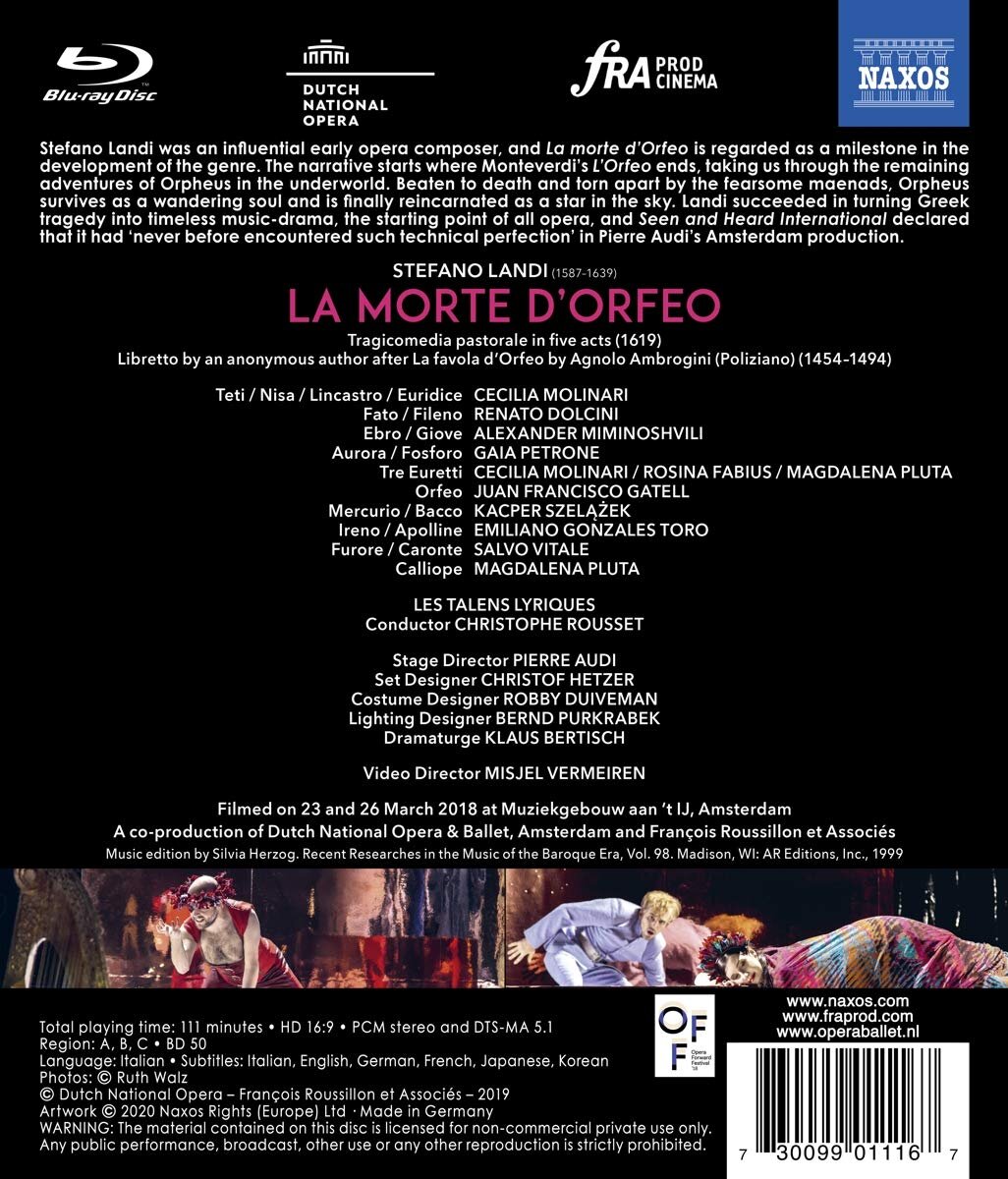

Stefano Landi La morte d’Orfeo opera to a libretto by an anonymous author. Directed 2018 by Pierre Audi at the Muziekgebouw, Amsterdam. Stars Cecilia Molinari (Teti/Nisa/Lincastro/Euridice/Euretti), Renato Dolcini (Fato/Fileno), Alexander Miminoshvili (Ebro/Giove), Gaia Petrone (Aurora/Fosforo), Rosina Fabius (Euretti), Juan Francisco Gatell (Orfeo), Kacper Szelążek (Mercurio/Bacco), Emiliano Gonzales Toro (Ireno/Apolline), Salvo Vitale (Furore/Caronte), and Magdalena Puta (Calliope/Euretti). Christophe Rousset conducts Les Talens Lyriques. Set design by Christof Hetzer; costume design by Robby Duiveman; lighting design by Bernd Purkrabek; dramaturgy by Klaus Bertisch. Directed for TV by Misjel Vermeiren. Sung in Italian. Released 2020, disc has 5.1 dts-HD Master Audio sound. Grade: A+
Landi’s La morte d’Orfeo was first performed in 1619, just 12 years after Monteverdi composed his L’Orfeo. Landi takes up the story where Monteverdi left off with Orfeo mourning the second death of his wife. This was just 3 years after the death of Shakespeare. If you ever wondered what music sounded like during the life of the bard, this recording will show you how sophisticated music could be then. There are 21 characters here played by 12 singers. Gatell playing Orfeo is the only singer I know by sight from other recordings. So I’ll not try to ID all the singers in all the screenshots—too much chance for error.
I researched the role played by Orfeo in early religion. Even the ancient writers were confused. We know for sure he was a musician/singer who charmed all (stones and animals also). But it seems he had a bad reputation for philandering and abusing women. Some ancient writers thought he was a pederast! Eventually he gets torn apart by enraged women seeking revenge. But then he winds up a star in the heavens. H’m, maybe he was the first Elvis.
As the show opens, it is Orfeo’s’ birthday, which calls for a party. It is also the day he will die.
Deities and spirits are at the party. On the couch below sits Aurora (Gaia Petrone) who will start the party with sunshine. The Three Breezes move in to caress Orfeo lasciviously, as is his due. Voyeurs include Mercury (Kacper Szelążek) in the leather cap and the river Hebros (Alexander Miminoshvili) in blue. All facing the audience are singing, as this is primarily a choral opera with relatively little music for soloists or small combinations of voices:
The first groupies! Center below, cheek to cheek with Orfeo is Aurora, who somehow manages to dominate the stage even with 8 other colorful characters acting up. This was also noted by Colin Clarke, who saw this live in 2018. Clarke wrote for seenandheard-international.com, “Gaia Petrone has the ability to make us forget the intervening years between the composition and the now; her emotions are as real and present as they would be in a person today.”
The singers often reassemble in different choruses. Next below, shepherds praise Orfeo. Why shepherds? Well, La morte d’Orfeo is classified as a Roman and Papal opera. Landi was primarily involved in sacred music. So even though La morte d’Orfeo is a secular work, Landi presents Orfeo as a Christ figure. And Bible tells us the arrival of Christ was heralded by shepherds watching over their flocks:
Orfeo invites Echo to the party the only way he can:
Apollo (Emiliano Gonzales Toro) is a guest with sound advice of the sort that had been scorned by Orfeo:
Bacchus was the only god not invited, since he always makes trouble. He crashes the party:
And Bacchus brings with him the Maenads, who will dismember Orfeo as punishment for his sins:
I think the singer below with the crown is Nisa (Cecilia Molinari), an ally of Bacchus. The girls in front sing soft, creepy echos of the commands given by Nisa:
The shepherds lament the death of our rock star:
In an especially moving passage, we meet Calliope (Magdalena Pluta), Orfeos’ mother. Calliope is worried about her son. Fileno (Renato Dolcini) is the brother of Orfeo. He carries the sad news about Orfeo to mom:
Orfeo was torn apart by the Maenads. His ghost treks to the river Styx in a second attempt to join Euridice in the underworld. Caronte, the boatman, doesn’t think this is a good idea:
Caronte produces Euridice. She has drunk of the waters of river Lethe and has forgotten Orfeo:
Euridice doesn’t even recognize her husband’s body parts left behind by the Maenads:
Orfeo is out of luck on earth. Now he’s willing to join Mercury in a trip to Olympus where Orpfeo will become a god:
There follows then startling images of Orfeo as a Christ figure ascending to Heaven:
This title is more buried treasure unearthed as it is the only video of the opera ever published. The keepcase booklet has good but sketchy information. Because the piece is such a rarity, it will be hard for a non-specialist to find more information or a libretto in Italian or English. But with diligent attention to the action and more research on the Internet, you should be able to figure out who all the singers are in the many roles.
Colin Clarke (quoted above) also reviewed the Blu-ray disc (as well as the live performance). He reports “it has been nothing less than pure joy to be reunited with the Dutch performance and to appreciate subtleties the Blu-ray camera work allows us to see that were not visible from my seat at the time of the live performance.” Noel Megahey, writing in operajournal.blogspot.com also gives the Blu-ray recording a glowing review. In particular Megahey notes, “ the dts HD-Master Audio 5.1 surround gives space to the beautiful open percussive sound of the period instruments.” Finally, David Shengold (November 2020 Opera News, pages 45-46) praises the “telegenic cast members” as well as the “vivid” performance by les Talens Lyriques. So this appears to be a sure winner for the early opera fan and a revelation for others.
I thought about reducing the grade for this title a bit because of some dark scenes and images illuminated by a harsh red light. In time I saw this would be too cruel. I decided to stick to the A+ because this is such a well-done job of a video that is, for now at least, both valuable and unique.
Here’s a trailer from Naxos:
And here’s a video from the Dutch National Opera. This may not be from the Vermeiren video file on the disc. But it accurately shows a scene included in the Naxos recording:
OR
















